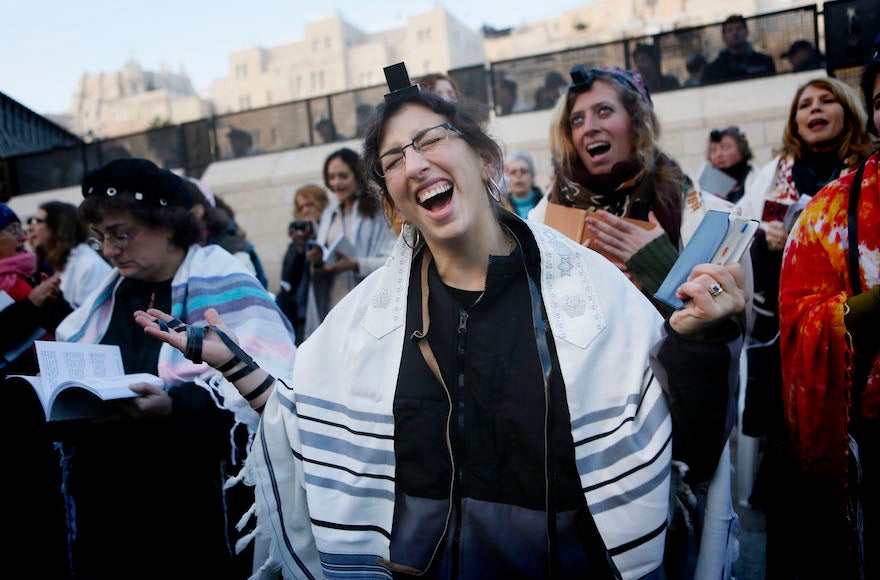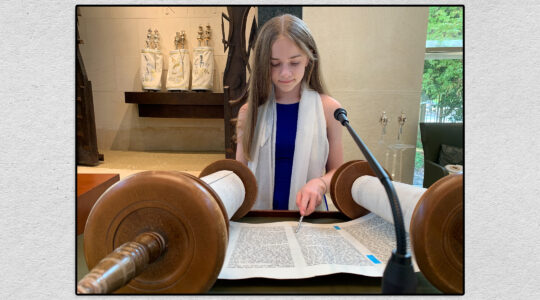(JTA) – On the morning of Dec. 1, 1988, a group of about 70 Jewish women entered the sacred space of the Western Wall. The women represented all the major streams of Judaism. Some wore prayer shawls or kippahs. Some did not. One woman cradled a Torah in her arms.
Together, their voices rose in prayer, marking the beginning of a movement. From that day until now, the Women of the Wall have fought for the right of women to pray together at Judaism’s holiest site – out loud, with tallit, tefillin and the Torah.
It has been no easy task.
For the past three decades, the Women of the Wall have faced down the many who object to their mission. During the women’s monthly prayer services at the wall, people have screamed and yelled, blown whistles, and hurled rocks and even feces at them.
Critic after critic told the women they were the ones disturbing the peace, causing problems and airing dirty laundry in public. They were commanded to stop and give up their fight without acknowledgement of the injustice they were battling.
But on Jan. 31, some of the Women of the Wall’s greatest hopes came to fruition. The Israeli government approved a deal recognizing mixed-gender, egalitarian services at a part of the Western Wall called Robinson’s Arch, an archaeological site adjacent to the traditional prayer area.
The government will expand Robinson’s Arch and make it accessible from the main plaza, where everyone enters to get to the Western Wall. Those coming to pray will be able to choose between an all-male section, an all-female section and an egalitarian section where anyone can pray however they choose.
An incredible victory, right?
READ: Op-Ed: Kotel compromise shows Israelis know they need American Jews
Yes. But much has been lost, too.
While Robinson’s Arch has been recognized for the first time as a place for Jews of any denomination to pray, the area known as the Western Wall has been officially designated an Orthodox Jewish prayer section ruled by Israel’s Chief Rabbinate.
For some – even members of Women of the Wall – this concession makes the deal a defeat rather than a victory. They refer back to the original goals of the movement: demanding room for women to pray with other women out loud, not separate but equal spaces.
Orthodox members of Women of the Wall and others face the same dilemma they always have: Where do you pray at the wall when you feel most comfortable with a separation of women and men but believe in the rights of women to pray out loud and read from the Torah?
Some of these women feel forgotten. Who will fight with them now? Have the Women of the Wall given up who they really are in this compromise?
Last week’s Torah portion provides some insight.
A newly freed people, escaping the bonds of Egyptian slavery, the Hebrews gather at the foot of Mount Sinai to hear the new laws of the community, to receive the commandments. They listen as Moses relays the following words: “When you acquire a Hebrew slave, he shall serve six years; in the seventh year he shall go free …”
Hold on one moment. The Hebrews were just freed from awful, brutal, demoralizing slavery. Why, then, is the Torah so quick to institute a new set of laws for the practice? If slavery was so terrible for us, shouldn’t our next step be ensuring that we are not inflicting the same horrific experience on others?
True, the new laws ensure rights for slaves, address them as human beings and even provide for them to be freed after a time. But still: slavery.
READ: Why the Western Wall compromise matters – and doesn’t
We must remind ourselves that in the ancient Near East, a world without slavery was unimaginable. Change could happen, but gradually – one step at a time. You can imagine our ancestors wondering, “Is this enough?”
Then as now, the answer is: “Maybe for now, but certainly not forever.”
As we consider the historic compromise on the Western Wall, we should remind ourselves that this is the way of change – as great leaders of social movements have understood.
The Rev. Martin Luther King Jr. said, “If you can’t fly then run, if you can’t run, then walk, if you can’t walk then crawl, but whatever you do, you have to keep moving forward.”
We are moving forward. Last month’s decision proves that.
The challenge is not to become complacent with this victory. We must continue to challenge the assumption that traditional Orthodoxy is and should be the norm at the Western Wall. We must continue to demand and raise our voices.
Gloria Steinem, another fighter for equality and justice, said, “I’m a realist, but I’m also a dreamer. And I’m not just a dreamer, I’m a hopeaholic.”
We Jews are hopeaholics, too. So we hope and pray for a time when every woman and man can pray, raising their voices, wearing the garments that provide meaning to their prayer and speaking the ancient words of our people at our holiest site, the Western Wall.
We grasp this hope while understanding the reality of the world. And we carry this hope with us as we move forward, striving for the next great victory.
(Debra Bennet is the associate rabbi at Temple Chaverim in Plainview, New York.)
JTA has documented Jewish history in real-time for over a century. Keep our journalism strong by joining us in supporting independent, award-winning reporting.






